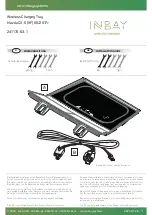
CAUTION:
Make sure the lug nut cover is fully
secure before driving to prevent it from falling
off.
Wheel Configuration
If you are installing new wheels or swapping them for
different ones, update your vehicle's wheel configuration
by touching
Controls
>
Service
>
Wheel Configuration
.
This allows Model X to learn the new wheels and provide
more accurate status updates on your vehicle. Select a
wheel from the drop down menu that matches the new
wheels you plan to install on Model X. Selecting new
wheels in the wheel configuration also changes the
wheels that appear on your vehicle's avatar on the
touchscreen.
Ensure you are aware if your vehicle is equipped with
staggered wheels, meaning the wheels are different
sizes in the front and rear. Check the front and rear tire
sizes marked on the tire sidewall to see if they match or
are different sizes. If the wheels are staggered, take
extra precaution to ensure the new wheels you install are
staggered in the same way as the previous wheels.
NOTE:
Changing your vehicle's wheel configuration can
impact range estimates, tire pressure warning levels, and
vehicle visualization.
WARNING:
Only use Tesla-approved wheels when
installing or swapping wheels. Using non Tesla-
approved wheels can cause serious damage. Tesla
is not liable for damage caused by using wheels
not approved by Tesla.
Tire Pressure Monitoring
Each tire should be checked monthly when cold and
inflated to the recommended pressures that are printed
on the Tire and Loading Information label located on the
driver’s door pillar (see
). If your vehicle has tires of a different size than
the size indicated on the vehicle placard or tire inflation
pressure label, determine the proper tire inflation
pressure for those tires.
As an added safety feature, your vehicle has been
equipped with a TPMS that displays a tire pressure
telltale (Tire Pressure Warning) on the instrument panel
when one or more of your tires is significantly under- or
over-inflated. Accordingly, when the Tire Pressure
indicator light displays on the instrument panel to alert
you about tire pressure, stop and check your tires as
soon as possible, and inflate them to the proper pressure
(see
Maintaining Tire Pressures on page 191
). Driving on
a significantly under-inflated tire causes the tire to
overheat and can lead to tire failure. Under-inflation also
reduces range efficiency and tire tread life, and may
affect the vehicle's handling and stopping ability.
If Model X detects a fault with the TPMS,
this indicator flashes for one minute
whenever you power on Model X.
NOTE:
Installing accessories that are not approved by
Tesla can interfere with the TPMS.
WARNING:
The TPMS is not a substitute for proper
tire maintenance, including manually checking tire
pressures and regularly inspecting the condition of
tires. It is the driver's responsibility to maintain
correct tire pressure, even if under- or over-
inflation has not reached the level for the TPMS to
trigger the Tire Pressure Warning on the
instrument panel.
Automatic Reset of TPMS Sensors
After replacing one or more wheels (but not after
replacing a tire or rotating wheels), the TPMS sensors
are reset to ensure tire pressure warnings are accurate.
TPMS sensors reset automatically after driving over
25 km/h for longer than 10 minutes.
NOTE:
After replacing a wheel, false tire pressure
warnings may display before you've driven 25 km/h for
longer than 10 minutes.
Replacing a Tire Sensor
If the Tire Pressure warning indicator displays frequently,
contact Tesla to determine if a tire sensor needs to be
replaced. If a non-Tesla Service Center repairs or
replaces a tire, the tire sensor may not work until Tesla
performs the setup procedure.
TPMS Malfunction
Model X has also been equipped with a TPMS
malfunction indicator to indicate when the system is not
operating properly.
The TPMS malfunction indicator is
combined with the tire pressure indicator
light. When the system detects a
malfunction, the indicator flashes for
approximately one minute, then remains
continuously lit. This sequence continues
upon subsequent vehicle start-ups as long
as the malfunction exists. When the TPMS
malfunction indicator is on, the system
might not be able to detect or signal
under- or over-inflated tires as intended.
Tire Care and Maintenance
194
MODEL X Owner's Manual
Содержание MODEL X 2015
Страница 1: ...MODEL X 2015 2020 OWNER S MANUAL Software version 2022 12 New Zealand...
Страница 51: ...Child Safety Seats 49 Seating and Safety Restraints...
Страница 62: ...Steering Wheel 60 MODEL X Owner s Manual...
Страница 276: ...Publication date 2022 4 14...
















































